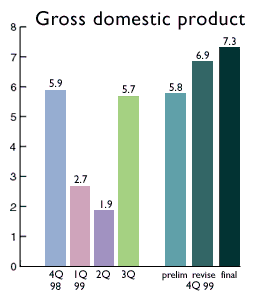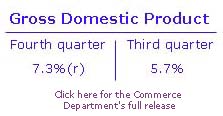|
GDP grows at strong pace
|
 |
March 30, 2000: 8:44 a.m. ET
U.S. economy expands at fastest pace in almost 16 years
By Staff Writer M. Corey Goldman
|
NEW YORK (CNNfn) - The U.S. economy advanced at the fastest pace in almost 16 years in the fourth quarter of 1999 as consumers at home and abroad continued to fuel strong demand for U.S.-produced goods and services, the government announced Thursday.
 Gross domestic product, the broadest measure of goods and services produced, grew at a 7.3 percent annual rate in the fourth quarter, the Commerce Department said, above the 6.9 percent increase expected by analysts. It was the biggest gain since a 9 percent jump in the first quarter of 1984, and dwarfed the third-quarter expansion of 5.7 percent. Gross domestic product, the broadest measure of goods and services produced, grew at a 7.3 percent annual rate in the fourth quarter, the Commerce Department said, above the 6.9 percent increase expected by analysts. It was the biggest gain since a 9 percent jump in the first quarter of 1984, and dwarfed the third-quarter expansion of 5.7 percent.
The GDP price deflator, a key inflation gauge, rose at a 1.9 percent annual rate, slightly below the 2 percent pace reported a month ago and a shade below economists' forecasts. For all of 1999, the U.S. economy grew at a 4.2 percent pace, while the GDP price deflator advanced 1.6 percent.
The numbers put the final seal on what analysts, investors and Federal Reserve officials already knew -- that the economy was running at white-hot pace at the end of the decade that could at some point ignite inflation. They also indicated that the economy will probably not slow down all that much in the first quarter, which ends tomorrow, despite five interest rate increases from the Fed in less than eight months.
Those undaunted consumers
"We're looking at undaunted consumers, with personal expenditures running at a heady clip," Jeoff Hall, an analyst with Thomson Global Markets in Boston, told CNNfn's Before Hours. That will likely continue to fuel growth in excess of 5 percent in the first quarter of 2000, leading to more rate increases from the Fed, he said. (540KB WAV) (540KB AIFF)
 The figures represent the third and final estimate of the nation's economic growth for the period. The government publishes three GDP estimates for each quarter as more information becomes available. It initially reported two months ago that the economy grew at a 5.8 percent pace in the fourth quarter. It revised that number upward to 6.9 percent a month ago. The figures represent the third and final estimate of the nation's economic growth for the period. The government publishes three GDP estimates for each quarter as more information becomes available. It initially reported two months ago that the economy grew at a 5.8 percent pace in the fourth quarter. It revised that number upward to 6.9 percent a month ago.
Financial markets registered little reaction to the report, which reflects what the economy was doing more than three months ago. Stocks looked past the report, with the Dow Jones industrial average and Nasdaq exchange once again taking divergent paths. Bonds gained as investors took comfort in the smaller-than-expected inflation number.
"Whether it's 7 percent or 7.3 percent the point remains the same: Growth is really strong and what's obviously an issue is how long this going to continue and what are we going to see going forward for the first few quarters of 2000," said Stephen Slifer, chief economist of Lehman Brothers.
More rate increases expected
The Fed lifted its benchmark fed funds rate earlier this month by a quarter point to 6 percent -- the fifth rate increase in less than a year - in order to slow the U.S. economy and ensure that inflation remains under wraps. Consumer prices advanced at a moderate 2.7 percent annual pace in 1999 -- in the final three months of 1999, prices rose 0.2 percent.
 While inflation continues to remain remarkably subdued, the Fed, particularly its chairman, Alan Greenspan, is concerned that consumers -- wealthier from gains in wages and the rising value of their stock market and real estate investments -- will continue to spend and become more willing to pay higher prices for goods and services. While inflation continues to remain remarkably subdued, the Fed, particularly its chairman, Alan Greenspan, is concerned that consumers -- wealthier from gains in wages and the rising value of their stock market and real estate investments -- will continue to spend and become more willing to pay higher prices for goods and services.
Higher productivity has allowed businesses to produce more without, as of yet, boosting their expenses, thereby keeping the cost of their final products low. At the same time, few analysts -- and Fed officials, in particular -- ever believed that strong growth without any gains in wages or prices would last forever.
Speaking in Tokyo Thursday, Fed Bank of New York President William McDonough said the Fed will likely keep raising rates to reign in consumer spending. The Fed wants to "reduce this excessive demand -- get consumer confidence to be strong, but perhaps not so euphoric," he said. McDonough is vice chairman of the Fed's policy-setting committee, which meets again May 21.
Surging demand from abroad
Higher rates tend to discourage consumers from spending by making it more expensive to borrow. Consumer spending accounts for more than two-thirds of U.S. economic output and has been one of the principal drivers of the current expansion, about to enter its record 109th month.
Part of the reason U.S. consumers have been so confident is the robust job market, where the jobless rate has hovered at a 30-year low for months. Separately, the Labor Department reported Thursday that the number of Americans filing new claims for unemployment benefits rose to 266,000 for the week ended March 25 from a revised 263,000 the week before.
Fueling the increase in growth in the final three months of the year was a surge in demand abroad for U.S.-made goods; products ranging from electronics and computer chips to automotive parts.
Exports of goods and services rose at a revised 10.1 percent annual rate in the fourth quarter, previously reported as an 8.7 percent increase. In the third quarter, exports rose at an 11.5 percent rate. Imports of goods and services grew at a revised 8.7 percent annual rate, previously reported as a 10 percent rate. Third-quarter imports advanced at a 14.9 percent pace.
Government spending also helped fuel economic growth in the quarter. Spending on public works projects such as building new schools and roadways increased at a revised 9.3 percent annual pace in the fourth quarter compared with the previously reported 9.2 percent gain. That was the biggest increase in spending since the third quarter of 1986. 
|
|
|
|
|
 |

|

